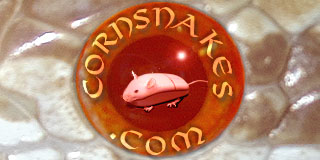From my retired SerpenCo.com website.
Hypomelanistic Okeetee Corn Snake
Combining Hypomelanism with one of the most beautiful of all the normal colored varieties of the corn snake can only produce an outstanding looking animal. Why not make a brilliantly orange and red colored snake even more brilliant? I honestly don't have more than a couple of young adults, so most of my stock will be coming from heterozygous animals. With that in mind, there is a bit of uncertainty about exactly what these guys will look like. But considering the parentage I think it would be difficult to get anything that would be disappointing. And how could they possibly look WORSE than a normal Okeetee, which is about as good as it gets in a normal colored corn snake?
Comparing even the babies of this cultivar to a regular Okeetee is like looking at night and day. Very intense reds and oranges even as youngsters, with large dorsal blotching and contrasting pattern. Of course, with this being a relatively new project, there is going to be a lot of room for enhancements and variations through selective breeding. Not to mention the various flavors of Hypomelanism around that will undoubtedly be used to further explore the potential of combining Hypomelanism with the Okeetee line of corn snakes.
I guess I need to bring up an impending problem here, that some people are aware of, but certainly not everyone. A couple of years ago I bought a couple of yearlings from Kathy Love of her line of Hypomelanistic Okeetee corns that she told me were spontaneously produced from a line of Okeetee corn snakes she had been working on. I thought this would be a good addition to my stock and help leapfrog over my using all heterozygous animals to produce my own Hypomelanistic Okeetees. Mine were done the long way by breeding Hypomelanism into Okeetee corns (and also purchasing some het animals from Bob Wallen in Tampa, FL), so I was still in the 'breeding het to het' stage of the project.
So in 1999, the pair I got from Kathy were big enough to breed, but instead of breeding them together, I bred the Hypomelanistic Okeetee male to a few of my het females and the Hypomelanistic Okeetee female from Kathy's line I bred with a couple of my het males. Needless to say, when the eggs all hatched and I had *no* Hypomelanistic Okeetees hatch out, I was sorely disappointed. At first I figured I just had a real rock solid case of bad luck. Anyone reading my text about the Hypomelanistic Lavenders will certainly be astutue enough to realize that I was having some very strong misgivings about my luck lately! But I just thought that my luck just CAN'T be that bad, and decided to work out a plan for the following year to determine if the cards were just stacked against me.
So, when breeding season 2000 rolled around, I decided to breed the Kathy Love Hypomelanistic Okeetee male to 3 different homozygous Hypomelanistic females, and the female of Kathy's line was bred only by homozygous Hypomelanistic males. That was going to give me four (4) clutches of babies that should have been 100 percent Hypomelanistic, taking luck completely out of the picture. As each clutch hatched out, I observed that there were NO Hypomelanistics at all hatching in ANY of the clutches. None. The evidence was firmly established that Kathy's line of Hypomelanistic Okeetees was clearly a new genetic trait that nearly identically duplicates the Hypomelanism we have been working with for years now. Although there certainly may be some identifers that will tell us which line of Hypo is which (type 'A' or type 'B'), I am rather doubtful this will be the case. I fully expect to breed the several pairs of animals I held back from the breeding trials mentioned above and get Hypomelanistics from both lines that will be indistinguishable from each other. I hope this is not the case, but even if there is any visible difference, it may be so subtle that it will be overlooked by nearly everyone. Most people whom have Kathy's line can see some telltales that identify them as being from her strain, but I strongly suspect those markers will not be readily apparent in subsequent generations of outcrossed individuals.
So, what does this mean? Quite simply, the world of corn snake genetics has now gotten still more complicated. If you get Hypomelanistic Okeetees from different sources, it is entirely possible that if you cross breed them, you may not get Hypomelanistic Okeetees at all in the offspring. It also means that if you get this spark of creativity and decide to breed a Hypomelanistic Okeetee to a Hypomelanistic Lavender to produce hypos het for Lavender and perhaps having an Okeetee influence, you will have to pick which Hypomelanistic Okeetee you use very carefully.
